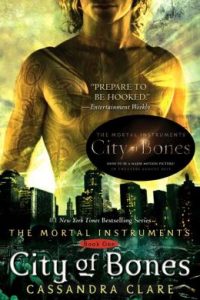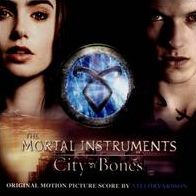There’s a big movie release this week, based on a best-selling series of young-adult fantasy novels. Young-adult fantasy novels have proved enormously profitable for the movie industry (certain flops excepted), and I suspect City of Bones will do very well for itself. Should teens read the book, see the movie, or skip both? I’m sure there are varying schools of thought, but here’s mine:
Clarissa Fray (Clary) encountered her destiny on the Sunday night that she and her nerdy best friend  Simon got into Pandemonium. Across the pulsing dance floor, she witnessed a beautiful girl in a long white dress lure a blue-haired youth into a back room and . . .
Simon got into Pandemonium. Across the pulsing dance floor, she witnessed a beautiful girl in a long white dress lure a blue-haired youth into a back room and . . .
Aside from some verbal glitches and awkward metaphors, the opening chapter of City of Bones is pretty effective: knives, beautiful people with swirling tattoos, a murder, a disappearing body, and Clary’s discovery that she can see figures and events that no one else can. That’s because she, like Jase and Alec and Isobelle of the white dress, is a Shadowhunter, a half-spirit being whose calling is to hunt down and kill demons. All the stories you’ve heard are true, she will later learn from the prophet Jeremiah: angels, demons, the nether world, spiritual warfare—everything except the divine center of all those tales, who is God Himself.
Mortal Instruments is the name of Cassandra Clare’s quartet of Shadowhunter novels. Following on the heels of Twilight, Shadowhunters #1-5 have sold millions of copies worldwide and inspired similar series like the Chronicles of Nick and Daughter of Smoke and Bone. The Twilight world of vampires and werewolves has expanded to include faeries, angels, demons, nephilim, chimera, and other quasi-biblical and mythological creatures–which, if they happen to operate in a big city, populate the genre known as urban fantasy. Mortal Instruments has all these, with a generous helping of thematic elements from Harry Potter–namely, a “normal” protagonist of questionable parentage and hitherto-unknown powers, who discovers a special calling to save the world. Or civilization as we know it, or something big like that.
City of Bones, the first volume in the series, is forwarded with quotes from Julius Caesar and Paradise Lost (also alluded to in the name of the club, Pandemonium), but soon descends to contemporary legend-mongering. Ordinary humans are “mundies” (i.e., mundane) to the paranormal “in” crowd, even though supercool Jase admits they have a certain appeal: Vitality just poured off them, waves of energy that filled him with a drunken dizziness. His lip curled. They didn’t know how lucky they were . . . Their lives burned as brightly as candle flames—and were as easy to snuff out. He later reflects on how humans routinely throw their lives away for money, power, or a charming smile—a reminder that young humans would do well to ponder occasionally. Otherwise the narrative builds predictable sexual tension between Jase and Clary and predictable speculation about her father, with lots and lots of exposition on the origins and backstory of the spirit world. There’s no actual sex but lots of blood (or “dark fluid,” if the victim isn’t entirely human) and profanity, amounting to almost 500 pages of time you’ll never get back.
Though it would never be confused with great literature, the cultural significance of Mortal Instruments and its ilk interests me. Earlier this week Emily reviewed the movie version of The Spectacular Now, a recent award-winning YA novel from a few years back. Her verdict, if I’m not giving too much away, is that it’s the saddest movie she’s seen in a while. I didn’t read this particular book, but I gather from reading about it that it falls into the class of realistic fiction that could be called sadder-but-(maybe) wiser, in which a teen boy or girl bumps up against reality (family problems, violence, depression, death) and comes away with a black eye and aching heart. The Perks of Being a Wallflower, The Fault in Our Stars, The Absolutely True Diary of a Part-Time Indian, Speak, etc. all trace a downward trajectory, with a tenuous upward twitch in the final pages that may resemble a happy ending. We’ve written about dark YA fiction before (see for example here and here) and will again, but for now I’ll just say the depressing nature of “reality” titles might have something to do with the explosion of best-selling fantasy titles.
 Whatever its faults, fantasy is usually straightforward. Though the hero may struggle with his inner soul, there’s no doubt about the division between evil and good. Obstacles are met face-to-face and overcome with superior strength. The bad guys are very obvious (skulls and bloody fangs are a dead giveaway) and the good guys always come through when the chips are down. Could it be that young adults—who aren’t quite as adult yet as they’d like to think—still need unmitigated hero stories? And with the natural world so ambiguous, might they find what they’re looking for more in the supernatural world?
Whatever its faults, fantasy is usually straightforward. Though the hero may struggle with his inner soul, there’s no doubt about the division between evil and good. Obstacles are met face-to-face and overcome with superior strength. The bad guys are very obvious (skulls and bloody fangs are a dead giveaway) and the good guys always come through when the chips are down. Could it be that young adults—who aren’t quite as adult yet as they’d like to think—still need unmitigated hero stories? And with the natural world so ambiguous, might they find what they’re looking for more in the supernatural world?
It’s the supernatural without a core, though. The shadowhunters and demons have their mythological beginnings but no Creator and Lord; they are what they are. When my son was little, Masters of the Universe action figures dominated the boy-toy market (the TV cartoon spun off the toy, not the other way ‘round). Sometimes, if there were no little boys around to play with, my son would cajole me into bashing MotU figures against each other in a semblance of story-telling. I asked him once what made the difference between good guys and bad. Since they were both bent on mutual destruction, what defined virtue? I used simpler terms of course, but the question was too philosophical for a five-year-old. What about for a fifteen-year-old? I sometimes wonder about that distinction in some of these paranormal/urban fantasy books. What defines virtue, and what is its source? Or is there really any such thing?
There might be a God, Clary, and there might not. Either way we’re on our own. This is Jace’s conclusion in City of Bones, and it’s a common thread through most of the genre. We’re on our own. A young person adrift in the modern world, with no objective good to cling to or build upon, might escape for a few hours into the black-and-white (or black-and-red) world of Mortal Instruments. Still they have to close the book eventually and return to “reality.” Clary is no role model; Jase has taught them nothing. Can the clear-cut distinctions between good and evil cross that line between imagination and daily life? Not in any way you’d notice.
It won’t necessarily harm a teen to read some of these books—both the reality-based and the fantasy. But we parents sometimes forget that they need to meet Christ in their literature, too, not just at church. Jesus must reign in our imaginations, or he can’t be said to reign at all.
So, what are some good YA titles to feed the teen imagination? Glad you asked! Strong readers might enjoy our readalong of C. S. Lewis’s That Hideous Strength, beginning here. For those who like their action packed, Andrew Klavan is a great choice: see our summer feature, along with reviews of Crazy Dangerous and If We Survive. Divergent (movie coming soon) is not exactly cheerful, but it hints at spiritual truth; see also Hayley’s review of Insurgent. Here’s a list of recommendations from a couple of years ago, and don’t neglect the classics, such as Jane Eyre, The Hobbit, and (not quite as classic) Beauty.
Support our writers and help keep Redeemed Reader ad-free by joining the Redeemed Reader Fellowship.
Stay Up to Date!
Get the information you need to make wise choices about books for your children and teens.
Our weekly newsletter includes our latest reviews, related links from around the web, a featured book list, book trivia, and more. We never sell your information. You may unsubscribe at any time.
We'd love to hear from you!
Our comments are now limited to our members (both Silver and Golden Key). Members, you just need to log in with your normal log-in credentials!
Not a member yet? You can join the Silver Key ($2.99/month) for a free 2-week trial. Cancel at any time. Find out more about membership here.
5 Comments
Leave a Comment
You must be logged in to post a comment.


Nicely written, Janie–thanks.
I have been wondering about this phenomenon for a while. I really appreciate your thoughts, so thanks for wading through 500 pages of “dark liquid” for us!
So am I right in thinking you read the book but have not seen the movie, Janie? I am afraid that if they do a good job with it, I would rather not see it!
I did something highly out of the ordinary and went to Barnes and Noble recently to pick up a copy of Code Name Verity (thank you, Betsy:-). It really was not pleasant to stand and peruse the book covers on display for teens. My 15 yo daughter (my super-reader) was not with me, but I really found myself hoping she would not have liked them either! I am so much more comfortable with the type of books you mentioned in the last paragraph. I wonder why these “paranormal” books are so popular with young people, even the young people at church?
Pat: I managed to get by with skimming the book, and no, I haven’t seen the movie. It won’t be on my list. I really think that teens are turning to paranormal fantasy in part because the distinctions are so clear-cut (but again, not based on particular moral system). They’re longing for clear lines between evil and good, wrong and right, and they aren’t getting it from our pluralistic culture. (And of course, part of the attraction is that paranormal guys are sexy. They’re so moody and alienated. Like James Dean–remember him?–with fangs or glitter.)
[…] Jesus Reigning the Imagination: RedeemedReader.com gives a great review of City of Bones, which of course is now a movie that many young adults and teens and preteens will be seeing. […]